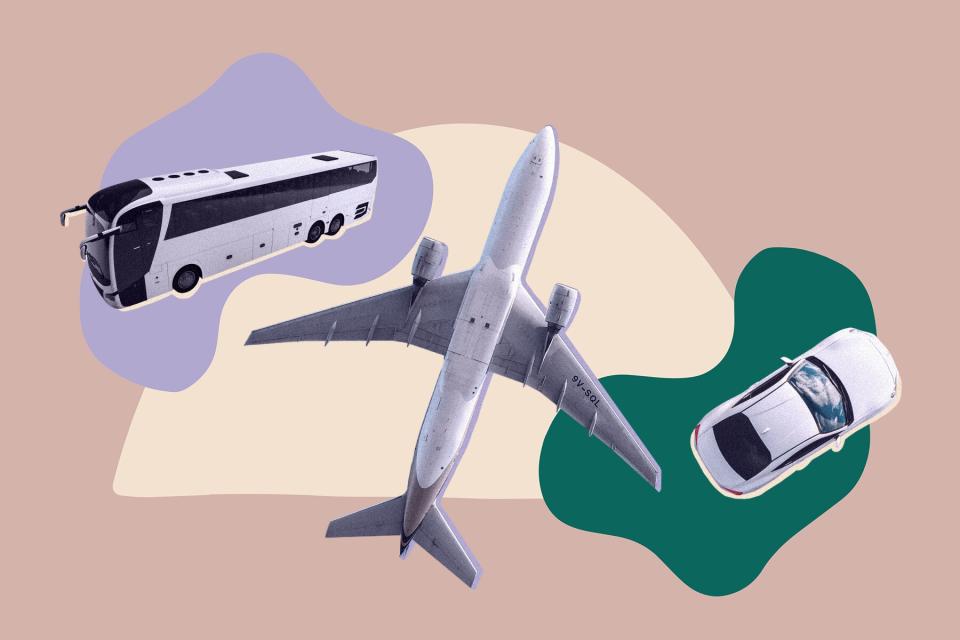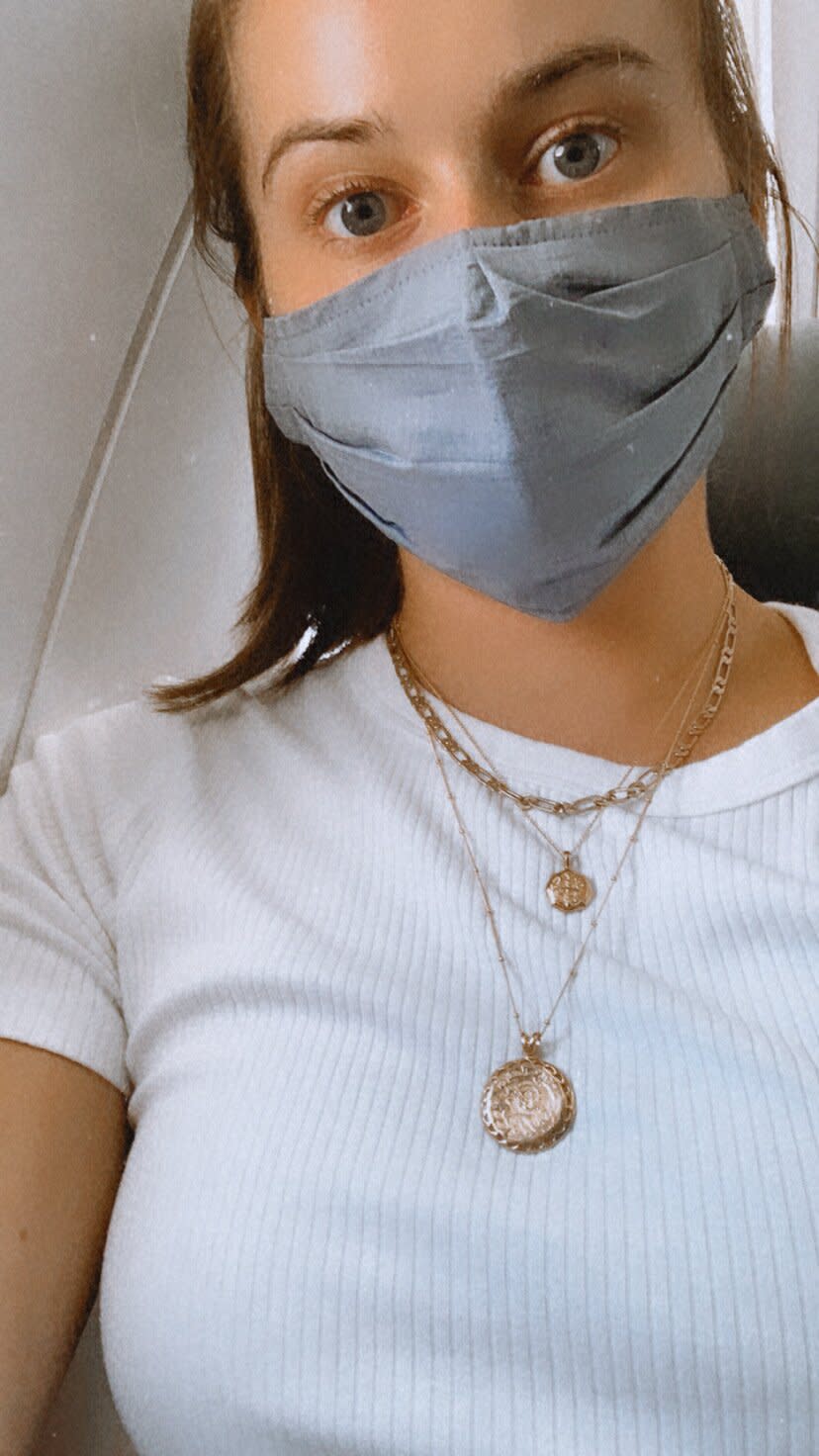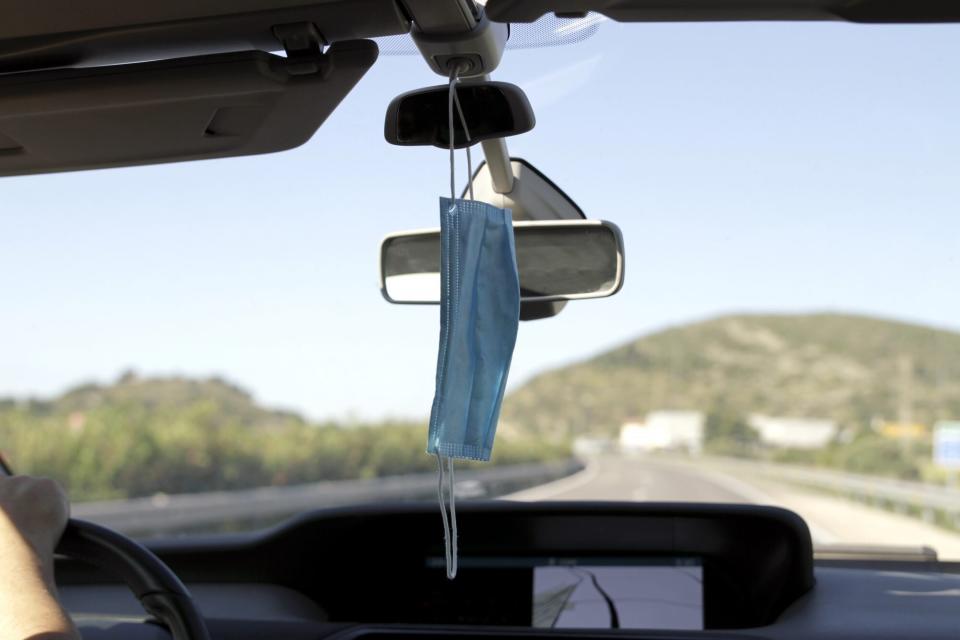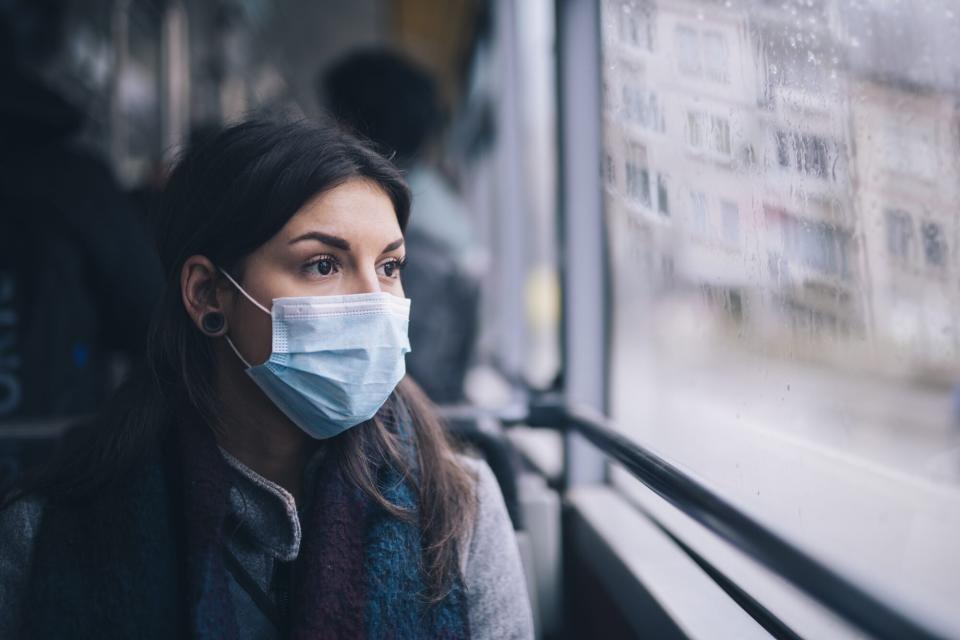I Flew and Took a Road Trip This Month—Here's Where I Felt Safest

Jenna Brillhart, HelloGiggles
Back in March, you couldn't have paid me to leave my house to go to the grocery store (bless you, Instacart) let alone travel to a different city or state. But now, as coronavirus (COVID-19) cases have dropped in most states across the U.S. and social distancing restrictions remain in place, traveling feels more feasible, albeit still nerve-wracking. So this past month I swallowed my nerves, put on my big girl pants (paired with a face mask, of course), and flew home to New York City after spending five months with my family in Iowa.
It turns out, the travel experience wasn't as daunting as I had cracked it up to be. In fact, I felt much safer flying than I did driving from Iowa to Minnesota back in July (more on that below). And after returning to the East Coast in mid-August, I stepped out of my comfort zone once again by taking a bus trip to the Jersey Shore over Labor Day weekend.
You might be debating flying, taking a road trip, or hopping on a bus yourself but feeling skeptical of how safe the experience will be. Below, read my pros and cons of the three modes of travel I took this month: flying, driving, and riding a bus during the pandemic. And just remember, any form of traveling comes with a risk right now, so do what feels most comfortable to you.
Most comfortable: flying

Claire Harmeyer, HelloGiggles
When the day came of my first air travel trip during the pandemic, nerves grumbled in my stomach. But the moment I arrived at the airport, the precautions that the airport put in place had put me at ease. Everyone inside—security, airline employees, waiters, and travelers like myself—were wearing masks, and I've never seen a cleaner airport before in my life. Everything looked well-sanitized, and chairs by the gates were marked with stickers reading "Do not sit" so that travelers could distance themselves from each other. It felt strange to walk through the terminal and see most restaurants and snack shops closed plus hardly anyone waiting by the gates—but this lack of congestion made me feel relaxed.
When it was time to board the plane, a Delta employee called passengers up row by row, starting from the back of the plane, to limit interaction with each other. As I stepped onto the plane, a flight attendant offered me a sanitizing wipe while another held out a plastic bag with a mini water bottle, snacks, a napkin, and another sanitizing wipe. I accepted both of their offerings and made my way to my empty row. I quickly wiped down my seatbelt, armrests, and the tray table before sitting down. Luckily, I had the row to myself the entire flight, and no one sat in front of or behind me, either. Flight attendants told passengers to keep their masks on when not eating or drinking or they would "kindly remind you" throughout the flight. No beverages were served to limit extra touching. I used the airplane bathroom once, and it looked cleaner than normal.
When it came to air quality, most airplanes nowadays are equipped with high-efficiency particle (HEPA) filters, which redirect air downward so that it never circulates over to your neighbors, which is helpful in slowing the spread of COVID-19.
Note: The travel experience might differ depending on the airport and airline you choose. Although the thought of traveling via airplane might scare you (it scared me, too), I'm here to tell you: I would do it again tomorrow, no question.
What to do if you fly: I recommend eating before you go and bringing your own snacks, because most airport restaurants and shops will likely be closed. Also, bring extra sanitizing wipes if you feel the need to wipe the chairs you'll sit on while waiting to board the plane.
Pros
Masks and social distancing policies are strictly enforced by airport and airline staff.
You are seated away from strangers in the airport and on the plane.
Airports and planes are extremely well sanitized by staff before getting on the plane and again by you (if you choose).
Cons
Most people arrive at the airport early in case of long lines, so you'll have to wait around in the airport before boarding—therefore being around more people than you would while driving.
You're in an enclosed space with people who might take their mask off while eating, but I was six feet apart from people who did so.
Somewhat comfortable: driving a car

Getty Images
In July, I took a seven-hour road trip with my mom and sister from Des Moines, Iowa, to our family's lake house in northern Minnesota. The length of the drive meant that we couldn't avoid stopping at gas stations to fill up our car—and empty our own tanks, if you know what I mean. (If you can last seven hours without peeing, props to you.)
Although I felt totally safe inside of our car, stepping inside gas stations was a different story. At the time in Minnesota, face masks weren't required indoors, and a surprising amount of people took this as an opportunity to go mask-free. I was shocked by how nonchalantly people seemed to be treating the whole situation (and I might have shot them a few disapproving looks, TBH).
My mom handled filling up our car with gas: She wiped down the nozzle before grabbing it and thoroughly sanitized her hands afterward. Since most people around us weren't even wearing masks, we took a wild guess that the gas nozzles weren't being wiped down regularly and were likely riddled with germs. While I waited in line for the bathroom inside the gas station, multiple people walked by me without a mask, so I got in and out of there as fast as possible. We also stopped at a Jimmy John's for lunch and opted for the drive-through, which felt safe. The employee with whom we interacted at the window was wearing a mask and gloves.
Overall, I would take another road trip, but I would limit stopping as much as my car and bladder would allow. If you take a road trip yourself, I would recommend you pack your own food so that you can refrain from stopping at a rest stop or drive-through to buy some.
Pros
You're separated from strangers for most of the trip.
You don't need to wear a mask in your car.
Cons
No strict rules are implemented at some pit stops, depending on the state you're traveling in.
Not all gas stations, drive-throughs, and rest stops are well sanitized, and there's no crowd control.
Least comfortable: riding a bus

Getty Images
For Labor Day weekend, I rented an Airbnb with five friends in Avalon, New Jersey, a cute beach town on the Jersey Shore. In order to get there from New York City, we had to take a two-and-a-half-hour bus ride. I'd ridden busses to other East Coast cities before, so I knew that they were typically close quarters. However, that was pre-COVID, when I didn't think twice about brushing shoulders with strangers for hours. Now, I think a lot more about who and what I'm coming into contact with—so I saw this bus ride in a whole new light.
My friends and I arrived at the Port Authority bus terminal about fifteen minutes before our departure time at 2:30 p.m. The nice thing about bus travel is that you can arrive right before your bus is scheduled to pull out of the station, eliminating the lengthy waiting-around-near-strangers aspect of airports. However, by the time we stepped onto the sold-out bus, there were no seats left together, so we were forced to sit next to strangers—so close that it was impossible not to brush thighs with the man sitting next to me.
As the bus pulled out of the station, the driver reminded everyone that we were required to wear masks during the whole ride. Luckily, my bus buddy was respectful, and he didn't take his mask off once—not even to take a sip of water. My friends, on the other hand, weren't so lucky. Many of them were seated next to inconsiderate riders who slipped their masks on and off throughout the ride. Since the only employee on the bus was the driver, these passengers were able to take their masks off without him noticing, unlike the airplane, where flight attendants were on the prowl, making sure everyone kept their face coverings on tightly.
Overall, I would not ride another bus right now due to the lack of personal space and the loose rules. However, if bus travel is your only option at this time, I recommend arriving in advance of your boarding time so that you can sit with whomever you're traveling with and bringing sanitizing wipes to clean your seat.
Pros
You hop right on and off the bus—no waiting around in the airport.
Cons
You're super close to strangers.
Rules aren't strictly enforced.
The space didn't feel clean/sanitized, and we weren't given wipes to clean the seat ourselves.

 Yahoo Sports
Yahoo Sports 